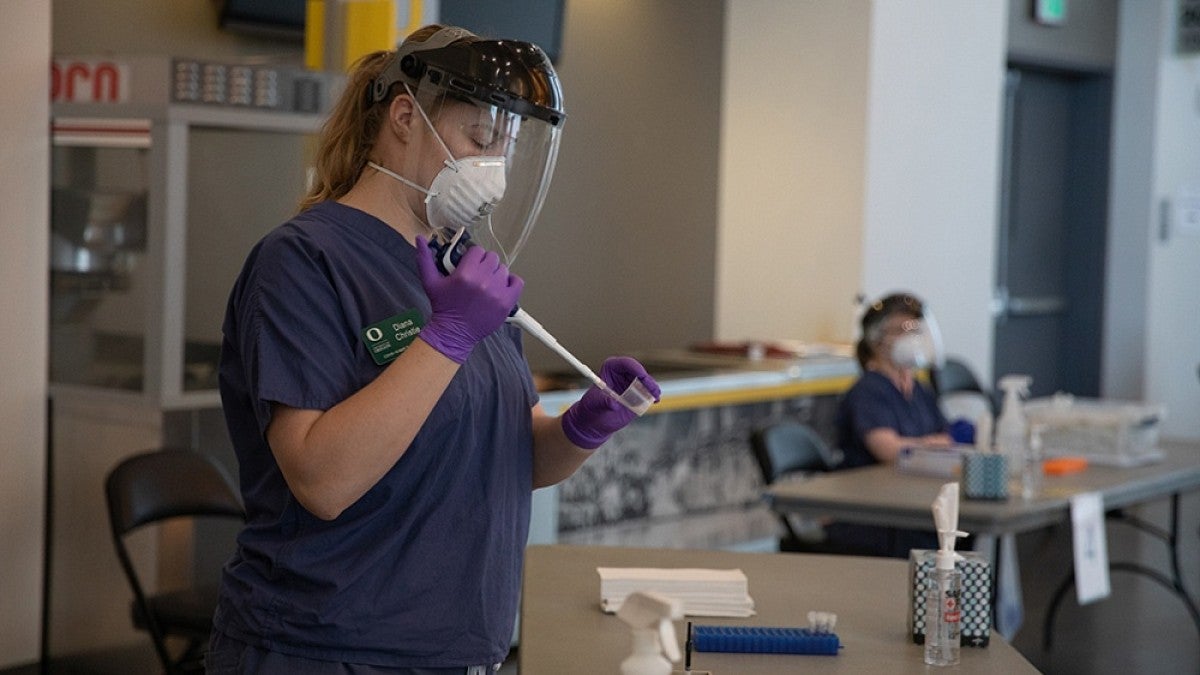Anyone who’s been tested for COVID-19 through the UO’s testing program is familiar with the ritual of sticking a swab inside a nostril, which then gets sent to a lab for testing.
On Thursday, May 6, the UO’s COVID-19 Monitoring and Assessment Program, known as MAP, piloted an alternative source for samples: saliva.
Using the new process, patients pool saliva in their mouths, then passively drool into a small plastic cup similar to a condiment container. Technicians will use a pipette to extract the sample and transfer it into a miniature-sized test tube. The test tube, which includes a unique barcode linked to the patient, is then sent to the UO’s clinical lab at the Phil and Penny Knight Campus for Accelerating Scientific Impact for processing, using advanced liquid handling robots.
Saliva samples can be processed at a fraction of the cost of a nasal swab and at far higher volumes, UO scientists said.
Because saliva contains fewer biological materials that might interfere with lab tests than nasal swabs, it is easier to process in the lab. And that means it costs far less to process— about $3 to test a saliva sample versus $20 for a nasal swab test, said Douglas Turnbull, interim senior director of the Genomics & Cell Characterization Facility, which oversees the MAP.
In addition, far more saliva samples can be processed in a day than nasal samples. Right now, the UO’s COVID-19 testing lab is capable of processing up to approximately 5,000 nasal swab samples in a day. At full capacity, the lab could test up to 13,000 saliva tests in a day, Turnbull said.
Thursday’s testing event at Matthew Knight Arena was a trial run for full-scale saliva sample collection. Saliva sampling previously had only been done on a research basis with members of the Monitoring and Assessment Program lab and participants willing to opt in. As the saliva testing ramps up, the UO will retain the nasal swab method as an option for its community testing events, said Hannah Tavalire, scientific coordinator for the MAP.
Some people are more comfortable with one kind of test than the other, said Brian Fox, the program’s executive director. But program officials want to make saliva collection a consistent part of the testing events it conducts for students who live in the residence halls, he said. The UO tests about 2,000 students each week.
UO scientists have been working on the testing method since July 2020. They started by partnering with counterparts from the Yale School of Public Health, which developed a test called SalivaDirect.
After receiving authority from Yale to run the new test, UO scientists quickly realized the saliva protocol was not that fast, Turnbull said. It required a step to enzymatically inactivate the saliva that was so time consuming and labor intensive that it made sense to continue using the nasal swab test, Turnbull said.
Meanwhile, scientists at the University of Illinois had developed their own saliva test. They found a shortcut: heating the raw saliva samples to boiling for 30 minutes to destroy inhibitors, reduce viscosity, and inactivate any virus present to make the samples safer to handle. This simple heat treatment step gave the same result as the lengthy enzymatic inactivation protocol used in the original Yale test.
UO researchers then generated data for Yale officials that showed the Illinois heat treatment protocol was just as effective as theirs, but quicker. After another round of Food & Drug Administration review, the new method to inactivate saliva was approved in March.
The UO is awaiting FDA approval to use an automated method to process the saliva samples using robots, but in the meantime is processing the samples manually. Turnbull noted that the effort by the MAP collection team and clinical lab team at the Knight Campus demonstrate how the UO’s deep expertise and scientific capacity can be put to real-world use.
—By Tim Christie, University Communications


